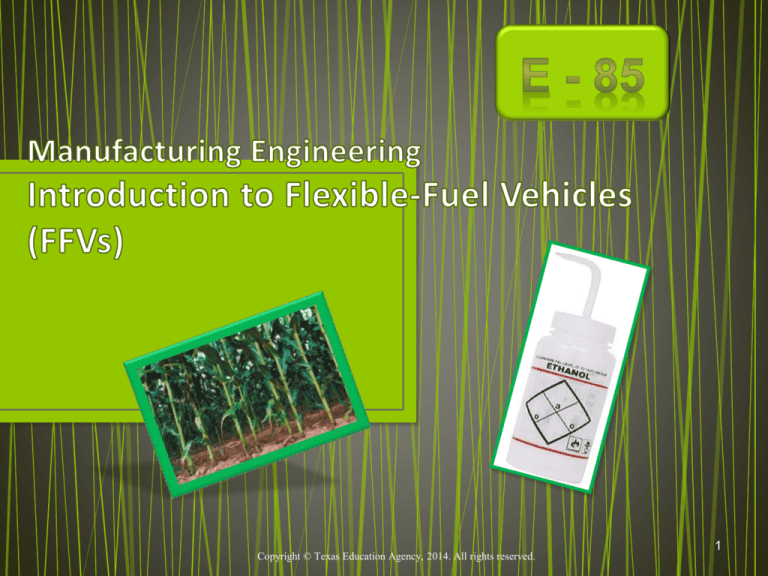
Copyright © Texas Education Agency, 2014. All rights reserved.
1
Please take out a sheet of paper and answer the
following:
A. Have you ever gone to a store to purchase a
specific item and the product was out of stock?
B. What options did you choose to take the place of
the item?
C. As a country, why should we reduce our
dependence on petroleum from foreign countries?
Copyright © Texas Education Agency, 2014. All rights reserved.
2
A. There are several important terms and definitions
students need to know.
B. Complete Introduction to Flexible-Fuel Vehicles (FFVs)
Terms and Definitions handout.
C. Students may work in pairs.
Copyright © Texas Education Agency, 2014. All rights reserved.
3
The automobile has revolutionized personal and commercial
transportation since it was first invented in the early 20th century.
Widespread use of automobiles has allowed several key industries
to grow and profit. The petroleum (fuel) industry is one of them.
The growth of the petroleum industry and the resulting gas crisis
in the 1970s caused many American leaders to question
dependence on foreign oil to meet national fuel needs. The
alternative fuel market was born and has continued to grow today.
The use of ethanol (corn-based), as a fuel alternative, has grown
steadily in the past few decades.
Copyright © Texas Education Agency, 2014. All rights reserved.
4
The widespread use of FFVs is very beneficial to our
economy, our environment, and to consumers.
Consider the following key facts about ethanol, a key
ingredient in the fuel for FFVs.
Ethanol is produced domestically and is renewable
Ethanol helps us reduce green house gas emissions
Ethanol is a high octane fuel and helps increase vehicle
performance
The production of Ethanol has created several hundred
thousand jobs in the USA
Copyright © Texas Education Agency, 2014. All rights reserved.
5
One of first FFVs was a Ford “Model T,”
built in the early 20th century. The vehicle had an
adjustable carburetor that would allow either
gasoline, ethanol, or both fuels to be used.
Today over one million FFVs are
produced per year in the USA.
Trucks, cars, and SUVs are
produced as FFVs.
Copyright © Texas Education Agency, 2014. All rights reserved.
6
FFVs are now produced by many manufacturers. The
fuel efficiency of these modern vehicles is very
impressive. Research several new models to find various
fuel efficiency ratings that range from 38 to 49 mpg.
Copyright © Texas Education Agency, 2014. All rights reserved.
7
Ethanol is an alcohol, and it has chemical properties
that are not compatible with components that are
normally used in vehicles designed only for use with
petroleum.
If Ethanol is used in a fuel system that does not have
compatible components, the system will degrade
due to corrosion and the disintegration of rubber
hoses, parts, and seals.
Copyright © Texas Education Agency, 2014. All rights reserved.
8
Automotive designers have corrected the problem
by designing fuel and engine systems with
components that can withstand the alcohol content
of ethanol.
Flex-fuel systems now operate efficiently with either
petroleum or ethanol-blended fuel.
Computerized sensors analyze the fuel composition
and make the required adjustments automatically,
with no change in vehicle performance.
Copyright © Texas Education Agency, 2014. All rights reserved.
9
Fuel Lines
Internal Engine Parts
Fuel Tank
Engine Electrical
Connections
Fuel Fill Port
Fuel Pump
Fuel Recognition
System
Engine Adjustment
System
Fuel Injection System
Copyright © Texas Education Agency, 2014. All rights reserved.
10








